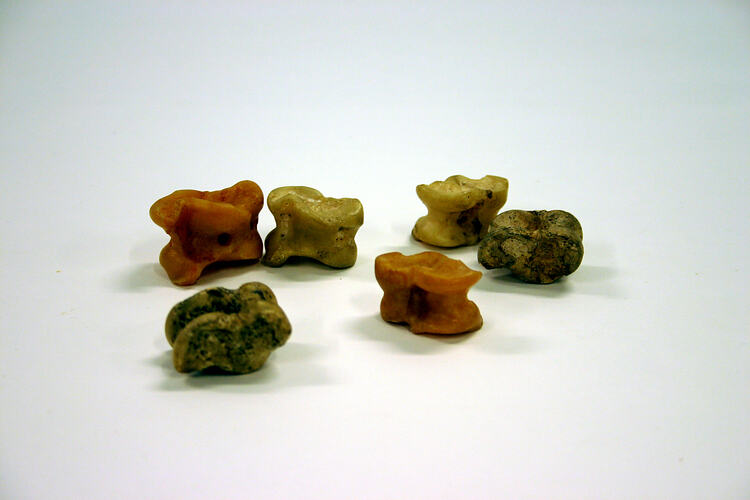Summary
Alternative Name(s): Knucklebone Jacks, Astragali, Astragalus, Talus
Six sheeps' knucklebones, dyed to different colours. Given to Dorothy Howard by a twelve-year-old boy in Perth, Western Australia, around 1955.
Knucklebones, or Jacks, is an ancient game, dating back to prehistoric times. The first jacks were natural materials - animal bones, stones, seeds and shells. Sheep's knucklebones were the most common type of jacks in Australia during the first half of this century, and children would colour them by boiling them in water with ink or dye. During the 1950s, mass-produced plastic knucklebones became available. These objects are examples of the very earliest type of mass-produced plastic replica knucklebones used by Australian children to play the game of Jacks. The size, shape and weight of real sheeps' knucklebones were replicated, in contrast to later versions which are much smaller and lighter.
This set is part of the Dorothy Howard Collection, gathered by eminent US folklorist and scholar Dr Dorothy Howard, who visited Australia as a Fulbright fellow in 1954-55 to document and research the folklore of Australian children. The Collection primarily contains documents, photographs and objects from Australia and the United States. It is now contained with the Australian Children's Folklore Collection (ACFC), unique in Australia, documenting contemporary children's folklore across Australia and in other countries reaching back to the 1870s. The Collection has a strong component of research material relating to Victoria.
Physical Description
Six sheeps' knucklebones in natural state. Five approximately the same size, one slightly larger. The large jack has a hole drilled through the centre. Two of the bones are weathered and discoloured.
More Information
-
Collection Names
Australian Children's Folklore Collection, Dorothy Howard Collection
-
Collecting Areas
-
Acquisition Information
Cultural Gifts Donation from Dr June Factor, 18 May 1999
-
Acknowledgement
Donated through the Australian Government's Cultural Gifts Program.
-
Date Used
-
Classification
-
Category
-
Discipline
-
Type of item
-
Keywords
Children's Folklore, Children's Play, Farm Animals, Food Technology, Games, Livestock, Sheep, Making History - Australian Childrens Folklore



